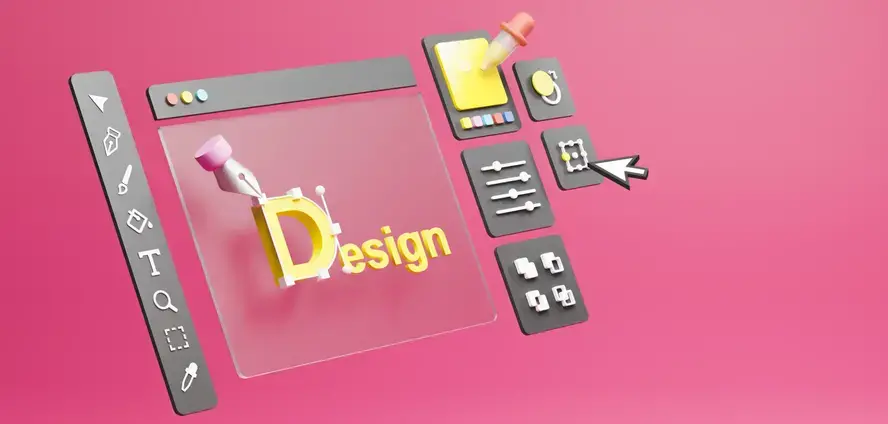A design system is a carefully organised and documented repository of design tokens, styles, and components that can be reused throughout a design (or several designs within an organisation). They’re used to eliminate redundancy, maintain consistency, speed up the UI design workflow, and help designers discern the use-cases of reusable design elements.
Also, now that design systems are starting to mature, it’s becoming more common for developers to contribute to them with code snippets and be more involved when it comes to reviewing and documenting them. Finally, design and code are starting to blur into one as designers and developers begin to share the responsibility of crafting user experiences.
Unfortunately though, modern UI design tools just aren’t introducing the necessary features needed to maintain design systems, so in addition to a UI design tool that can help you create design systems, you’ll also need a DSM (Design System Management) tool. Design system management tools are equipped for comprehensive design system documentation and act as your team’s single source of truth for everything design and code.
Let’s take a look at the 5 best design system management tools on the market today.
1. Figma
Figma is considered to be the best and most used UI design tool today by a wide margin, according to the Design Tools Survey. As a design system tool, Figma leads the way in similar fashion. Let’s take a look at what Figma does exactly.
Designers can use Figma to maintain consistency throughout their designs by creating and then reusing Components (which can have dynamic content, multiple variants, swappable nested instances, and toggleable layers), Text Styles, Color Styles, Grid Styles, and Effect Styles. Together they help designers create minimal yet highly flexible design system libraries.
It’s the ultimate tool for creating design systems.
However, Figma doesn’t offer a way to create design system documentation. Instead, designers must create documents using Notion or a dedicated design system management tool, and then link to them from the relevant Figma Style or Component. That’s right, Figma isn’t technically a design system management tool, but it's certainly much more equipped to be than Sketch and Adobe XD. Figma is a UI design tool with some design system features, and since every designer needs a UI design tool anyway, the question is what secondary design system management tool should we use with Figma?
Zeroheight, Zeplin, and Storybook are all terrific choices. Notion isn’t technically a design system management tool either, but it’s well-liked, free, and can be used as such.
Of course, there are alternatives to Figma. If, for some reason, you don’t vibe with Figma, there’s Sketch or Adobe XD. However, Sketch isn’t available on macOS and neither have any design system features beyond being able to create Styles and Components. You can’t create documents with them nor link to documents created using other tools.
Therefore, the best way to handle design systems is to choose Figma and combine it with one of the aforementioned design system management tools, which we’ll take a look at now.
2. Zeroheight

Zeroheight is a secondary tool, meaning that design systems need to be created using a UI design tool such as Figma before being synced to zeroheight, where they can be documented and maintained there.
But why, when Notion is free? Well, the benefit of using a dedicated design system management tool such as zeroheight is that they can be branded, creating a sense of ownership. Also, zeroheight design systems automatically show visual previews, are easier to organise, and look far more impressive as a result.
Regarding documentation, developers can embed rendered code snippets, either natively with zeroheight or by importing them from Storybook) or CodeSandbox. To help developers write these code snippets, zeroheight translates design styles to code (although UI design tools already do this, having the feature in zeroheight means less tool-switching for developers).
3. Zeplin
Already widely respected as a design handoff tool that translates design styles to more code languages than that of UI design tools such as Figma, Zeplin’s more recent venture into design system management means that the design systems you maintain with it translate to code well. Zeplin is also able to integrate with Storybook so that developers can very easily import code components to be used as documentation. But more importantly, Zeplin contextually embeds your documented design system elements into your design handoffs where relevant, which is super impressive and very useful for developers.
As well as Storybook, Zeplin also integrates with Trello, Microsoft Teams, Jira, and Slack for seamless collaboration, which is what makes Zeplin feel more mature and enterprise-friendly than its competitors. Zeplin is undoubtedly the best option for collaboration and maintaining a seamless workflow.
In all other aspects, Zeplin is very comparable to zeroheight — it’s easy to use and the design systems look great once they’re finished.
Overall, if you’re looking for a solution to both design handoff and design system management in a single tool, Zeplin is a terrific choice and would be an asset to your product workflow.
4. Notion
Although not a design system management tool, Notion is well liked for its versatility as a writing/documentation tool. Can you use it to hack together a design system? Of course, especially since you can embed Components and Styles from Figma (or something similar) into Notion documents; and vice-versa (if using Figma), link Components and Styles to Notion documents, keeping everything interconnected.
As for code documentation, developers can either write code into Notion (which is easy to do since it’s Markdown-based) or embed code components from external tools such as Storybook.
However, it’s just not a design system management tool and this feels evident when using it and looks evident when seeing the end result. It’s very much a manual workflow that can make teams feel exhausted after a while, even causing burnout. But, if your design system is small or you’re looking for something that’s free, then you’re looking for Notion. It is, for sure, the best option for those on a budget.
5. Storybook
Finally, let’s talk about Storybook. What sets Storybook apart from other design system management tools is that it’s mostly aimed at developers. It helps with design system documentation and the ‘stories’ can even be interacted with, since Storybook is a code playground of sorts. You can embed the stories into zeroheight, Zeplin, and Notion, or you can use Storybook as your secondary design system management tool.
These isolated, interactive code components can be linked to from UI design tools such as Figma so that designers can check that the implementation looks and behaves correctly. However, there aren’t any features that inform developers about changes to design systems. Developers are somewhat isolated from the design side of things, and designers often say that Storybook isn’t very designer-friendly. With that in mind, Storybook might be best utilised as just a code component manager for developers.
Similarly to Notion, Storybook doesn’t help designers and developers collaborate effectively, so if you really do want to use Storybook for its awesome code component management, ideally you’ll want to use it with zeroheight or Zeplin, importing your stories into them for context and convenience.
Conclusion
Most would agree that Figma + zeroheight is the best combination of tools for managing design systems in the long run; although, Figma + Zeplin is a close second. Personally, I would rather use Zeplin due to its origins as a design handoff tool, because design system elements are shown in context.
That being said, all of the design system management tools mentioned in this article have legitimate use-cases and are worth checking out.
It’s also worth checking out Knapsack, which is quite new but could end up being a much better execution of what Storybook is trying to offer — a more atomic approach to design system management with complete code rendering and tighter integration with UI design tools.
Also worth taking a look at is Supernova, which not only converts design to code (like, completely), it also helps developers build code rendering engines called ‘Blueprints’ for custom design-to-code conversion — exactly how you want it, production-ready.
It’s very interesting to see the various ways that design system management is being solved. It’s certainly a concept that’s still maturing (as are design systems themselves), so these solutions will improve over time, especially when it comes to keeping design and code synced up. Or maybe design-to-code conversion (like what Supernova is trying to create) is just around the corner? When it comes to technology, who really knows?
What’s your design system management setup?
And if you want to ensure your perfectly designed website is built on a solid platform, consider using Verpex web hosting. Our managed hosting plans for WordPress are optimised for speed and excellent performance.
Frequently Asked Questions
How do I choose a design for my website?
One of the most important things when creating a website for your art is the design. Even though your pieces of art might be amazing, people will leave if your site is hard to navigate. This is why it’s important that the site is easy on the eyes and easy to navigate.
What type of design should my fitness blog have?
When you’re a beginner, don’t go crazy with the design of the site. The most important thing is to have a site that looks professional, easy to read, and fast.
Are WordPress-free themes safe?
People often think that free themes have low quality. However, free WordPress themes actually have high quality and are free to use.
Do DIY blogs make money?
Yes, DIY blogging can bring you are steady income. There are several effective and proven methods to monetize your DIY blog and earn some real money.

Previously, blog editor at Toptal and SitePoint. Now I advocate for better UX design alongside industry leaders such as Adobe, InVision, Wix, CreativeBloq, Net Magazine, and many more.
View all posts by Daniel Schwarz





















